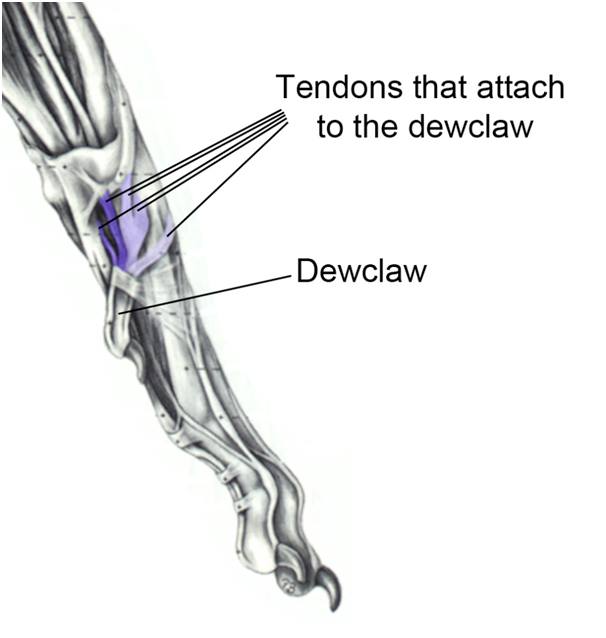Before I knew any better, I was always told that Dew claws don’t matter, and they just “get in the way” and its better to just have them removed to avoid any issues down the road. So when I got my first dog, I asked my old vet about it and (thankfully) he advised against it, not giving any real reason at the time, but looking back now I am thankful that he advised against it as over the years I’ve learned many things about canines that I simply didn’t know back then and something that seemed so simple at the time could have had repercussions in my dogs life later on down the road. Below is some information that I’ve found personally useful and informative on the topic.
Great info from McIntyre Canine Rehabilitation
“The Function of Dewclaws 101
Front dewclaws are typically removed by some at 3-5 days of age, because they are believed to be a non-functional digit that poses an unnecessary risk for being injured.
In standing, the front dewclaw may not appear to be functional because it doesn’t come in contact with the ground. However, observing the dewclaw when the dog is in motion tells a different story.
Five tendons attach to the dewclaw and play an important role when the dog is in motion. For example:
When a dog’s lead leg is on the ground during the gallop or canter, the dewclaw is on the ground to stabilize the carpus
When a dog turns, the dewclaw digs into the ground to support the structures of the limb and prevent torque
If a dog does not have dewclaws, there is a higher potential for the carpal ligaments to stretch and tear which could result in laxity and arthritis over time (OUCH!). This can then result in more stress being generated through the dog’s carpus, elbow, shoulder, and spine as it tries to compensate for the lack of digit.
On the other hand, the rear dewclaws do not have associated tendons and are considered non-functional (though they may be required for some breed standards to be present).
In speaking with many vets, you would be surprised at how few dewclaw injuries they see.
So- given the front dewclaws’ functional use, why are we so quick to remove them?
In dogs, the most common injuries seen by many rehab providers and vets occur in the shoulder complex, yet we don’t see shoulders being removed. Food for thought!
Here are some cool videos if you’d like to learn more about the functional use of dewclaws in dogs:”
Do the Dew(claws)?
M. Christine Zink DVM, PhD, DACVSMR
I am a vet that works exclusively with performance dogs, developing rehabilitation programs for injured dogs or dogs that have had surgery as a result of performance-related
injuries. I have seen many dogs now, especially field trial/hunt test and agility dogs, that have had chronic carpal arthritis, frequently so severe that they have to be retired or at least carefully managed for the rest of their careers. Of the over 30 dogs I have seen with carpal arthritis, only one has had dewclaws. The others have all had them removed.
If you look at an anatomy book (Miller’s Guide to the Anatomy of Dogs is an excellent one – see figure below) you will see that there are 5 tendons attached to the dewclaw. Of course, at the other end of a tendon is a muscle, and that means that if you cut off the dew claws, there are 5 muscle bundles that will become atrophied from disuse.
Those muscles indicate that the dewclaws have a function. That function is to prevent torque on the leg. Each time the foot lands on the ground, particularly when the dog is cantering or galloping, the dewclaw is in touch with the ground. If the dog then needs to turn, the dewclaw digs into the ground to support the lower leg and prevent torque. If the dog doesn’t have a dewclaw, the leg twists. A lifetime of that and the result can be carpal arthritis. Remember: the dog is doing the activity regardless, and the pressures on the leg have to go somewhere.
They can be absorbed by the dewclaw, or they will move up and down the leg to the toes, carpus, elbow, and shoulders.
Perhaps you are thinking, “I never have had one of my dogs have carpal pain or arthritis.” Well, we need to remember that dogs, by their very nature, do not tell us about mild to moderate pain. If a dog was to be asked by an emergency room nurse to give the level of his pain on a scale from 0 to 10, with 10 being the worst, their scale would be 0, 0, 0, 0, 0, 6, 7, 8, 9, 10. Most of our dogs, especially if they deal with pain that is of gradual onset, just deal with it and don’t complain unless it is excruciating. But when I palpate the carpal joints of older dogs without dewclaws, I almost always elicit pain with relatively minimal manipulation.
As to the possibility of injuries to dew claws. Most veterinarians will say that such injuries actually are not very common at all. And if they do occur, then they are dealt with like any other injury. In my opinion, it is far better to deal with an injury than to cut the dew claws off of all dogs “just in case.”
Anatomical diagram viewing the medial side of a dog’s left front leg demonstrating the five tendons that attach to the dewclaw

Looking for custom tailored ketogenic meal plans for your dog? click here!
